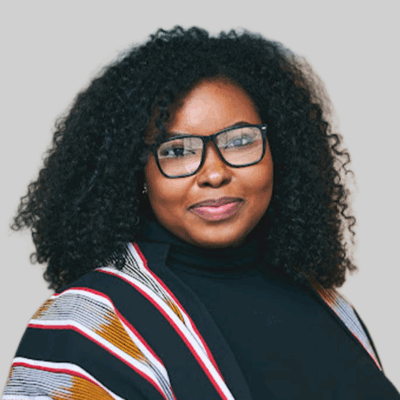A Conversation with Cooperation Canada’s Research and Program Officer, Andy Ouedraogo.
Andy Ouedraogo is the Research and Program Officer for Cooperation Canada’s first strategic foresight project, the Global Cooperation Futures Initiative, funded by the International Development Research Centre (IDRC). One year after the launch of the project, Andy recounts how far she’s come and presents a new report, the Landscape Analysis of the International Cooperation Sector.
You joined Cooperation Canada as Research and Program Officer to lead our first ever project on strategic foresight funded by the International Development Research Centre (IDRC). Now, a year in, where are we at?
It has been quite the journey and I’m happy to say that one year in, we have achieved quite a few milestones including the recent conclusion of our research-intensive phase commemorated with the launch of a Landscape Analysis of the International Cooperation Sector; a scan of emerging trends and drivers of change. We’ve also engaged close to 220 Canadian and global international development actors in our workshops, focus group discussions, and surveys, with a view to co-create knowledge and include as many voices and perspectives as possible.
Can you tell us how you managed to navigate the complex landscape of foresight?
Anticipating the future can be daunting. Leading this project feels like building a car while driving it. We are not only steering and navigating the vehicle but also installing components, fine-tuning the engine, and adjusting the design—all while on the move. During the first few months, the fear of not getting it right loomed like a shadow over my eager enthusiasm. Anticipating the future? Who, me? But I’ve learned to shift my focus away from achieving pinpoint accuracy and towards embracing the iterative process of refining strategy, incorporating new insights as they surface, re-assessing methodologies and course correcting where needed.
Futures don’t follow a script, and plans will inevitably change. Rigid timelines and linear approaches are not the most responsive to change and would limit one’s ability to identify new trends and emerging issues that could potentially be disruptive. Being adaptable and working with a strategic foresight partner who embraces flexible and agile methodologies has been key to navigate uncertainties and keep our project on course.
I will also add that good foresight hinges on the diversity of the data set, including input from a wide range of stakeholders. By engaging diverse voices and perspectives, we gain a more comprehensive understanding of potential future trajectories. An example of how Cooperation Canada did this is through our regional dialogues, organized in partnership with regional networks of CSOs in five different regions. These dialogues were instrumental in validating existing domains based on regional nuances, challenges, and future aspirations for the sector. Moreover, they enabled us to incorporate intra-personal observational knowledge, derived from participants’ firsthand observations of local change and their perceptions of the future of development influenced by local and regional events and trends.
Any lessons you could share or pieces of advice for CSOs seeking to venture into foresight?
The realization that the future doesn’t have to be a single fated outcome has been profound. Recognizing this plurality has broadened my perspective and highlighted the complexity of plausible future scenarios and so my first piece of advice would be to embrace the plurality of the future.
Then, I would say scope wisely to ensure relevance, actionability, and impact. Future studies could easily take you in so many directions, especially when looking into global systems. You quickly realize how interconnected the world is and may end up trapped in a giant spider web not knowing in which direction to go. By defining clear boundaries and objectives, not only have we been able to tailor the foresight process to suit our specific needs and context, but we were also able to choose appropriate methodologies, approaches, and tools that are best suited to the Futures Initiative.
My final piece of advice would be to opt for an iterative approach and emphasize process over precision. It is so crucial to allow space for continuous learning, experimentation, and improvement to ensure the relevance of the outcome.
The fun of strategic foresight isn’t just in the outcome; it’s in the process. It’s in the laughter during brainstorming sessions, the “aha” moments when a trend clicks, and the shared excitement when a foresight exercise sparks creativity. So, embrace the process.
What does the future look like for you?
Well, the future is much closer than you would imagine. With just two workshops remaining, I look forward to co-creating three transformative scenarios for international cooperation with CSOs and other development actors, as well as studying and discussing their implications for the next 7-10 years.
Click here to register for our scenario creation workshop!


